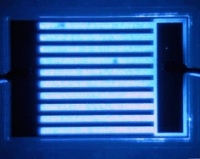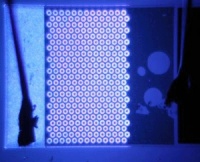The firm, mLED, says its microLEDs have a wide range of applications from communications and printing circuit boards to neuroscience and studying biological cells.
Each device is made up of an array of up to several thousand LED elements, each just 20 micrometres in diameter. They can easily be programmed to create specific patterns of light without external components.

These patterns of light could be used in hand-held projectors or to print on light-sensitive surfaces without a mask, for example, in the production of circuit boards.
‘The power density, versatility and compactness of microLEDs makes them ideally suited for these applications,’ said Dr Jim Bonar, mLED’s chief executive.
The microLEDs are also more compact and have better beam quality and faster operating speeds than their macro counterparts.
Because the lights can be turned on and off so quickly and have a high energy output, they can also be used in communications or for measuring the ability of cells to emit light by fluorescence.
The beam from the microLED stimulates the cell’s fluorescent activity, but is then turned off quickly enough to allow scientists to monitor the light coming from the cell without interference from the LED.
The firm expects the first commercial applications of the devices to be in printing and for use in neuroscience through a process that has yet to be patented.
But mLED is also sending out test kits to allow potential clients to see the possibilities of the technology for themselves.
‘The challenge has been to narrow down the applications,’ Simon Andrews, business development manager at Strathclyde’s Institute of Photonics, told The Engineer. ‘That’s why we’re taking the strategy of sending out demo units and letting people feed back to us.’
A possible application for the device has already been developed and patented by researchers at Imperial College London. They have produced a striped version of a microLED that can be used in microscopy to see the different layers of a biological cell.

The technology was developed at the Institute of Photonics by a research team led by director of research Prof Martin Dawson, associate director Dr Erdan Gu and research technologist Dr Gareth Valentine, all of whom will act as consultants to mLED.
Braveheart Investment Group led the £150,000 funding round into mLED, investing via the Strathclyde Innovation Fund (SIF) and the Alpha EIS Fund. Scottish Enterprise’s Scottish Seed Fund also participated in the round.
The university also obtained major funding from the Scottish Enterprise Proof of Concept Fund and from the EPSRC.





Nanogenerator consumes CO2 to generate electricity
Whoopee, they've solved how to keep a light on but not a lot else.